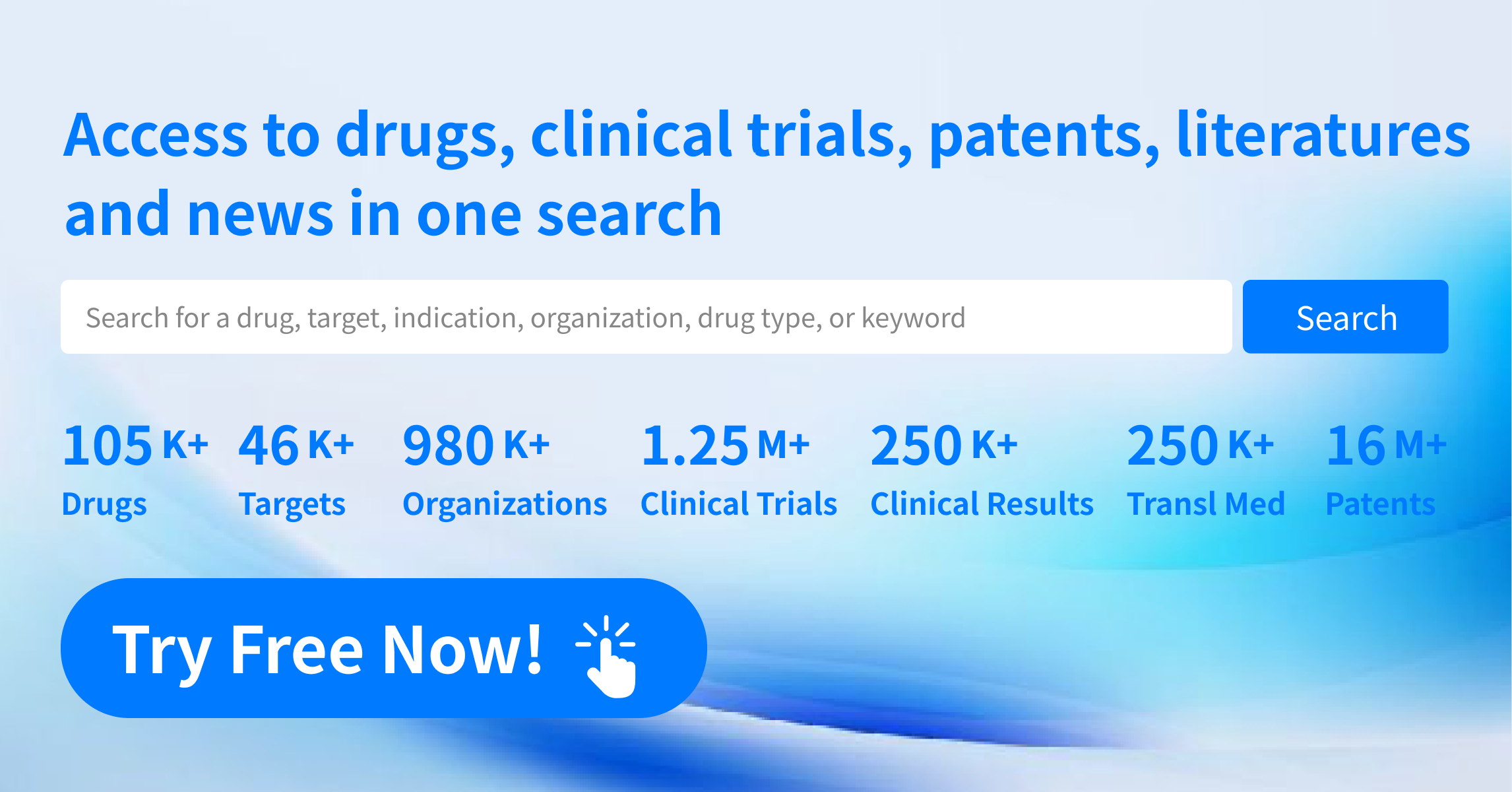Nav1.8 Inhibitors: The Next-Generation Non-Opioid Analgesics Reshaping Pain Management
Nav1.8 inhibitors hold significant economic value and exhibit promising development trends in the global analgesics market. In 2022, the global market size for analgesic drugs reached approximately USD 91.14 billion, and it is projected to approach USD 90 billion by 2028. In China, the analgesics market was valued at approximately RMB 122.6 billion, with the expectation that China will become the largest and fastest-growing pain treatment market worldwide over the next decade. As a novel class of analgesics, Nav1.8 inhibitors are poised to disrupt the existing market dominated by nonsteroidal anti-inflammatory drugs (NSAIDs) and opioids, emerging as a potential game-changer in the field of pain therapeutics.
Mechanism of Action of Nav1.8 Inhibitors
Pain is a complex physiological and psychological process, with its initiation occurring at the peripheral sensory nerve terminals. Pain-inducing stimuli (such as thermal, mechanical, or chemical signals) activate a variety of ion channels, especially the transient receptor potential (TRP) channels. This activation leads to the influx of cations (e.g., Na⁺, Ca²⁺), causing membrane depolarization. Once the depolarization reaches a threshold, voltage-gated sodium channels (VGSCs) are activated, triggering sustained action potentials that transmit pain signals to the spinal cord and eventually to the cerebral cortex for perception and processing.
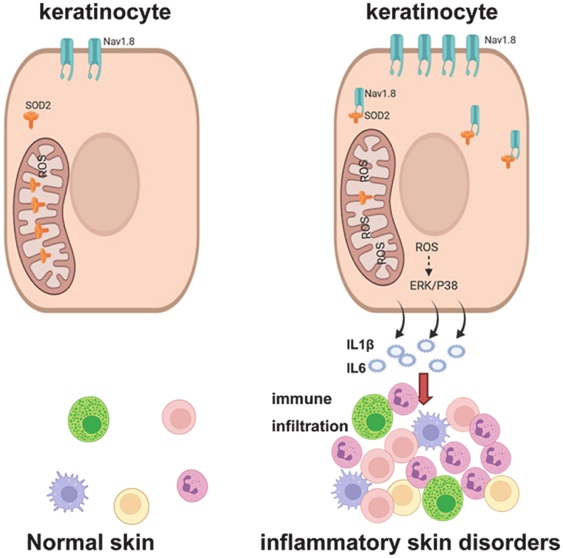
Among the VGSCs expressed in adult primary sensory neurons, Nav1.7, Nav1.8, and Nav1.9 each serve different roles in generating and propagating action potentials. Nav1.7 initiates and maintains the early phases of action potentials, with mutations linked to conditions such as congenital insensitivity to pain and erythromelalgia. Nav1.9 contributes to resting membrane potential modulation and reduces the action potential threshold, enhancing neuronal excitability. However, Nav1.8 has drawn particular attention due to its pivotal role in chronic and inflammatory pain. It is primarily located in small-diameter, unmyelinated sensory neurons (C-fibers), where it maintains the action potential peak and duration, increasing excitability and prolonging signal transmission.
Nav1.8 is a tetrodotoxin-resistant sodium channel predominantly expressed in nociceptive neurons and plays a key role in peripheral pain signal transmission. Upon activation of receptors like TRP channels by noxious stimuli, cation influx depolarizes the membrane potential. Once the threshold is reached, voltage-gated sodium channels like Nav1.8 open, generating repetitive action potentials that relay pain signals to the spinal cord.
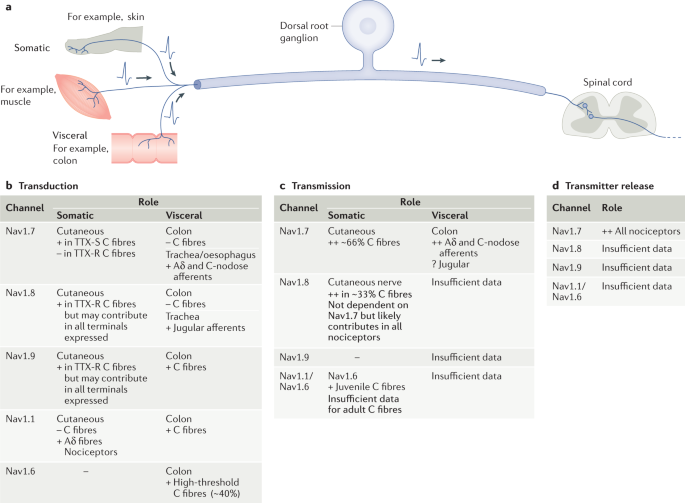
By blocking the Nav1.8 channel, Nav1.8 inhibitors prevent the transmission of pain signals from the peripheral to the central nervous system, offering a novel analgesic mechanism. Because Nav1.8 is mainly distributed in pain-sensing neurons and not involved in central nervous system activity, these inhibitors are unlikely to cause the non-selective side effects seen with other VGSC blockers or the addiction associated with opioids. They also do not impair motor, cognitive, or memory functions. Furthermore, combination strategies involving multiple pain mechanisms—such as inhibition of VGSCs, TRP channels, and inflammatory mediators—could provide more comprehensive pain control and open new therapeutic avenues.
One of the primary challenges in Nav1.8 inhibitor development has been the lack of a high-throughput screening system using mammalian cells that stably express Nav1.8. However, recent advances using chimeric channel strategies and large-scale screening of peptide toxin libraries have led to the discovery of highly selective Nav1.8 inhibitors. One such compound, μ-EPTX-Na1a, has demonstrated superior analgesic effects compared to morphine with fewer side effects, making it a promising lead compound. These findings provide a theoretical basis for developing new analgesics targeting Nav1.8 and establish the mechanistic link between Nav1.8 inhibition and analgesic activity.
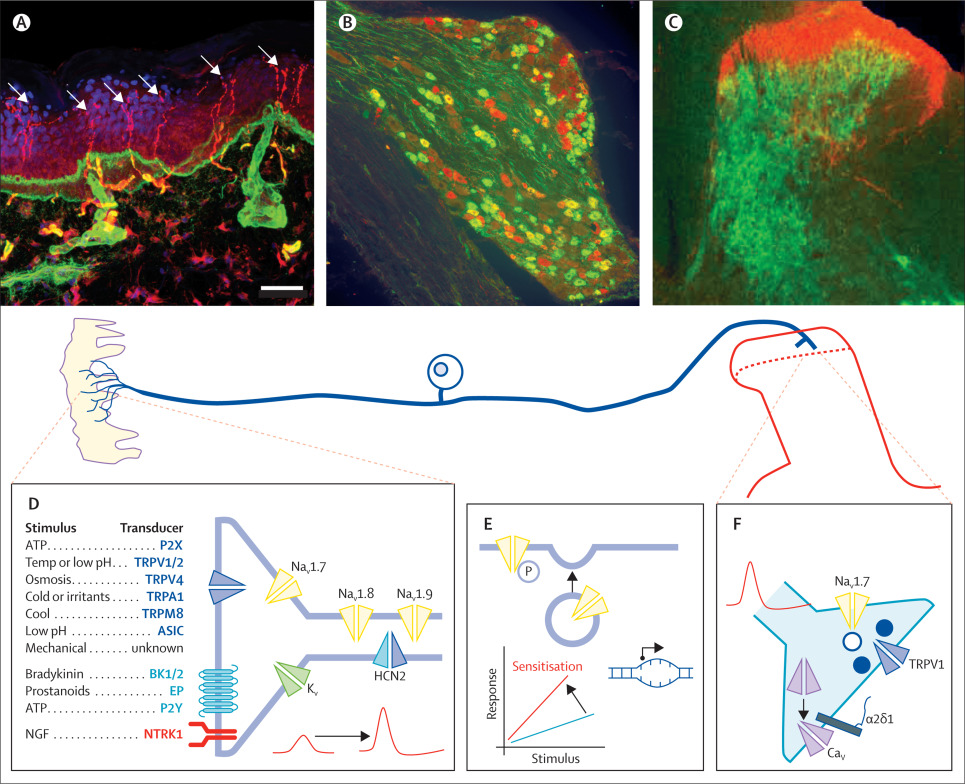
Market Drivers for Nav1.8 Inhibitor Development
Globally, the prevalence of chronic pain is estimated at 35%–45%, with annual healthcare expenditures for pain management reaching USD 75 billion and growing at 10%–20% annually. In developed countries, chronic pain has become the third major health issue after cardiovascular and oncological diseases. In China alone, over 300 million people suffer from chronic pain, with 20 million new cases each year. With an aging population, this number is expected to rise. At the same time, advances in medical technology and increased surgical procedures are driving greater demand for postoperative pain management. While opioids remain effective, their side effects and addiction risks have underscored the urgent need for safer, non-opioid analgesics.

Opioids such as morphine and oxycodone can relieve pain effectively in the short term but are prone to causing addiction, leading to severe socioeconomic burdens and adverse effects like constipation, nausea, and respiratory depression, limiting their clinical use. Non-opioid analgesics, such as NSAIDs and local anesthetics, provide only partial relief and may cause gastrointestinal bleeding or renal impairment with long-term use, making them suboptimal for many pain types.
Recent advances in molecular biology and pharmacology have enabled more precise drug design targeting specific molecular pathways. Nav1.8, as a voltage-gated sodium channel predominantly expressed in sensory neurons, is considered an ideal target for novel analgesics. High-throughput screening and computational chemistry techniques have accelerated drug discovery, allowing researchers to identify selective, low-toxicity candidates in shorter timeframes. Preclinical studies have consistently shown that Nav1.8 inhibitors produce robust analgesic effects in various pain models with minimal side effects.
For example, VX-548 has demonstrated excellent pain relief in preclinical models and significantly reduces postoperative pain. It has also shown positive results in clinical trials, proving both safe and effective, thus advancing the development of this promising drug class.
Nav1.8 Inhibitor Market Landscape
Vertex’s VX-548 is currently the most advanced Nav1.8 inhibitor in development. On January 30, 2025, Vertex Pharmaceuticals announced that the FDA had approved Suzetrigine for the treatment of moderate-to-severe acute pain, marking the first non-opioid analgesic approved in over two decades. As of January 30, 2024, Vertex announced positive results from its three Phase III trials (VX22-548-104, VX22-548-105, and VX22-548-107), which met primary endpoints by significantly improving pain scores in patients with moderate-to-severe acute pain.
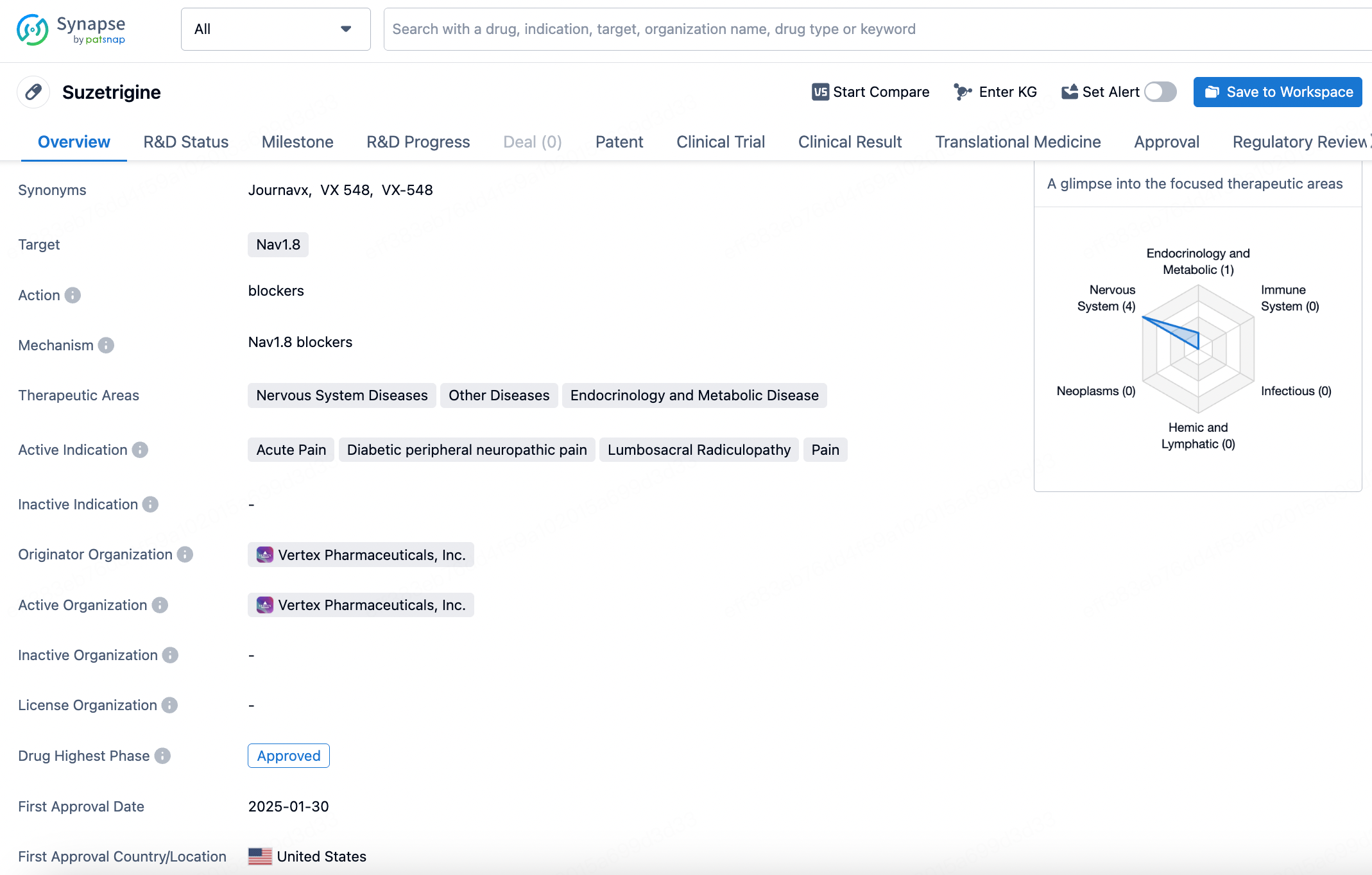
VX-548 has also shown promising results in a Phase II dose-ranging study for painful diabetic peripheral neuropathy (DPN). On December 13, 2023, Vertex reported statistically and clinically meaningful pain reduction across all dose levels with good tolerability. The company plans to advance VX-548 into pivotal trials after discussions with regulators to further validate its safety and efficacy across various pain types.
VX-548 demonstrates high selectivity for Nav1.8, inhibiting it specifically without affecting other sodium channels—an important feature that reduces off-target side effects and enhances safety. The drug has shown a favorable safety profile in clinical trials, with no significant serious adverse events, supporting its strong potential for clinical use. In addition to acute pain management, VX-548 has shown efficacy in chronic pain indications like diabetic neuropathy, expanding its commercial prospects.
Other Key Players and Candidates
Hengrui’s HRS-4800, currently in Phase II trials, has shown significant analgesic effects in multiple preclinical pain models and the potential to reduce opioid usage. This indicates its promise in addressing opioid dependency and side effects.
Jemincare’s JMKX000623, now in Phase II trials, has demonstrated favorable analgesic efficacy and safety. In March 2022, Jemincare entered into an exclusive licensing agreement with ORION CORPORATION for the development, manufacturing, and commercialization rights of JMKX000623 outside Greater China. This collaboration has accelerated the drug’s globalization while bringing Jemincare additional resources and market opportunities.
Hyperway Pharmaceutical’s HBW-004285 has shown excellent analgesic effects and selectivity in preclinical studies. Having completed Phase I trials, it is scheduled to begin Phase II studies in 2024. Thanks to its favorable pharmacokinetics and sustained analgesic activity, HBW-004285 ranks among the leading global Nav1.8 inhibitors in development.
Joincare and Fermion’s FZ008-145, a second-generation, highly selective Nav1.8 inhibitor, is in the IND (Investigational New Drug) application phase and shows great development potential. With potent, non-addictive analgesic properties, the Nav1.8 target has already achieved five clinical proof-of-concept (POC) validations. Joincare, with its robust R&D capabilities, is poised to solidify its position in the pain treatment market through this pipeline asset.
Conclusion
The development of Nav1.8 inhibitors not only holds the potential to disrupt the current dominance of NSAIDs and opioids in the pain management market but also brings renewed hope for more effective and safer analgesics. As the global burden of chronic pain rises and demand for postoperative pain control increases, the market need for Nav1.8 inhibitors will continue to grow.
Advancements in high-throughput screening and computational chemistry have accelerated drug discovery, allowing researchers to rapidly identify highly selective, low-toxicity drug candidates. As a new class of analgesics, Nav1.8 inhibitors—owing to their unique mechanism and significant clinical effects—are poised to capture a key share of the future pain therapeutics market. With more companies and research institutions entering the field, the development of Nav1.8 inhibitors is expected to further accelerate, providing safer and more effective treatment options for pain patients worldwide.
How to obtain the latest research advancements in the field of biopharmaceuticals?
In the Synapse database, you can keep abreast of the latest research and development advances in drugs, targets, indications, organizations, etc., anywhere and anytime, on a daily or weekly basis. Click on the image below to embark on a brand new journey of drug discovery!
Reference
- 1.Zhang, Y., et al., Nav1.8 in keratinocytes contributes to ROS-mediated inflammation in inflammatory skin diseases. Redox Biol, 2022. 55: p. 102427.
- 2.Goodwin, G. and S.B. McMahon, The physiological function of different voltage-gated sodium channels in pain. Nat Rev Neurosci, 2021. 22(5): p. 263-274.
- 3.Waxman, S.G. and S.D. Dib-Hajj, The Two Sides of Na(V)1.7: Painful and Painless Channelopathies. Neuron, 2019. 101(5): p. 765-767.
